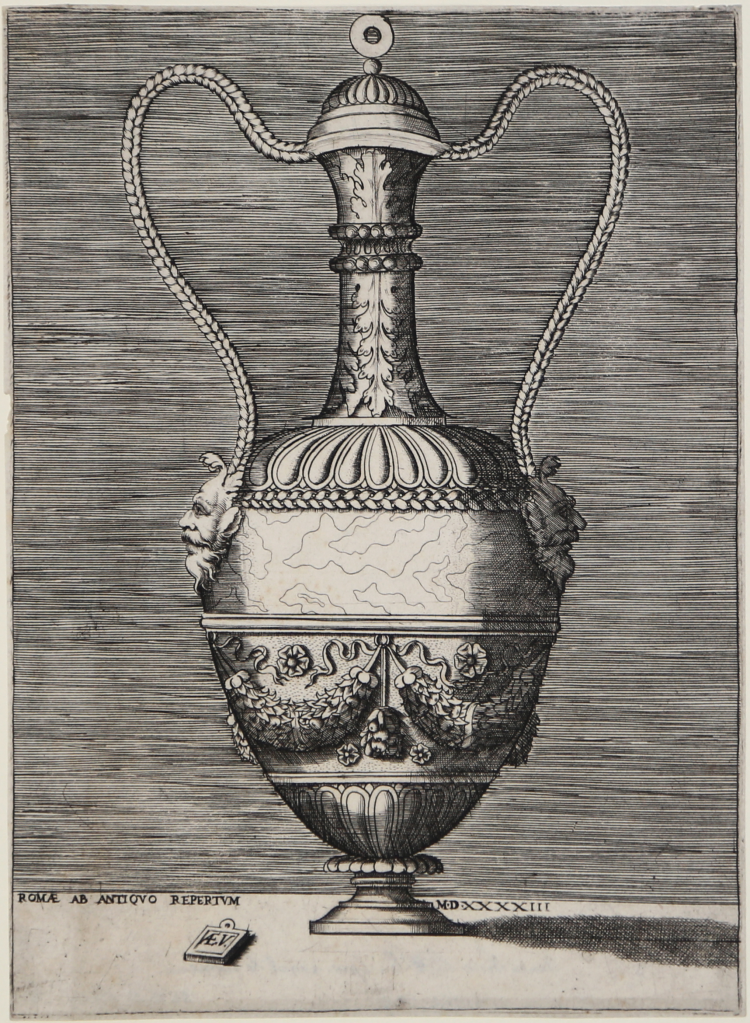




| Reference: | s6766 |
| Author | Enea VICO |
| Year: | 1543 |
| Measures: | 180 x 250 mm |



| Reference: | s6766 |
| Author | Enea VICO |
| Year: | 1543 |
| Measures: | 180 x 250 mm |
An antique vase with two handles terminating in mascarons on the shoulder, and with body adorned with a frieze of marbled stone (?), and festoons.
Engraving 1543, lettered at bottom 'Romae ab antiquo repertum MDXXXXIII' and 'AEV' in a tablet.
Belonging to the series "Differenti soggetti di Vasi dall'antico" ("Different types of ancient vases").
Example in the first state, before the number VIII was added at bottom left.
Beautiful proof, on contemporary laid paper, no watermark, trimmed at the platemark, in very good conditions.
From a series of prints engraved by Enea Vico and depicting antique vases, a number of which were after Agostino Veneziano, perhaps in turn connected to similar designs by Giulio Romano.
The series exists in two states before and with the numbers. Editions of the second state were published by Antonio Lafrery (Lafrery volume, V&A) and Pietro de' Nobili (Berlin 1125). Miller notes that the two plates engraved after Agostino Veneziano (numbered I and XIIII in the second state) do not appear in the first state; as they open and close the set, she suggests they were perhaps meant to fool the unsuspecting buyer into thinking he was buying the Agostino Veneziano set, and that they were not engraved by Vico.
Lit: De Jong/De Groot, 'Ornamentprenten in het Rijksmuseum I, 15de & 16de eeuw', Amsterdam 1988, cat. No.650; Fuhring in his review of the latter in Print Quaterly vol VI, No.3, September 1989, pp.322-334; and Miller, 'Sixteenth- century Italian ornament prints in the Victoria and Albert Museum', 1999, cat. No.68.
|
Bartsch 426
|
Enea VICO (Parma 1523 - Ferrara 1567)
|
Enea, son of Francesco, was antique dealer, drawer, engraver and numismatist. He was born in Parma on January 29th, 1523, according to what Huber says. After the first school years in the city, and very likely after he made acquaintance with the works of Giulio Romano, Vico moved to Rome in 1541. He then worked for Tommaso Barlacchi, who also engraved with him a series of Grottesche, in 1542. In the classical atmosphere of Rome, Vico’s style developed according to that of Perin del Vaga and Francesco Salviati, but always with Parmigianino as main reference. Around the first half of the century and after studying the works of Marcantonio, Agostino Veneziano, Caraglio and Bonasone, Vico acquired his own, peculiar style which can be seen in his main works. From Rome Vico moved to Florence, where he worked for Cosimo I, and then went to Venice, in 1557. In 1563 he is already in Ferrara, working for Alfonso d’Este till his death in 1567.
|
|
Bartsch 426
|
Enea VICO (Parma 1523 - Ferrara 1567)
|
Enea, son of Francesco, was antique dealer, drawer, engraver and numismatist. He was born in Parma on January 29th, 1523, according to what Huber says. After the first school years in the city, and very likely after he made acquaintance with the works of Giulio Romano, Vico moved to Rome in 1541. He then worked for Tommaso Barlacchi, who also engraved with him a series of Grottesche, in 1542. In the classical atmosphere of Rome, Vico’s style developed according to that of Perin del Vaga and Francesco Salviati, but always with Parmigianino as main reference. Around the first half of the century and after studying the works of Marcantonio, Agostino Veneziano, Caraglio and Bonasone, Vico acquired his own, peculiar style which can be seen in his main works. From Rome Vico moved to Florence, where he worked for Cosimo I, and then went to Venice, in 1557. In 1563 he is already in Ferrara, working for Alfonso d’Este till his death in 1567.
|